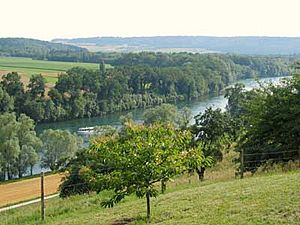Hegau facts for kids
The Hegau is a special area in southern Germany. It's known for its many hills that were once active volcanoes, but now they are extinct, meaning they won't erupt again. This landscape is found around the city of Singen (Hohentwiel).
The Hegau is located between some important natural features. To its east is Lake Constance, a large lake. The Rhine River flows to its south, and the Danube River is to its north. To the west are the Randen mountains, which are part of the Swabian Jura. The name "Hegau" was first written down in the year 787 AD, using the Latin words in pago Egauinsse.
Contents
What Makes the Hegau Special?
The Hegau is often called a "volcanic landscape" because of its unique hills. These hills are actually the remains of ancient volcanoes. Over millions of years, the softer rock around the volcano cones wore away, leaving behind the harder volcanic rock. These leftover parts are called "volcanic stubs" or "volcanic cones."
Hohentwiel: A Famous Volcanic Hill
The most famous and easily recognized volcanic hill in the Hegau is the Hohentwiel. It stands tall and can be seen from far away. Hohentwiel is a great example of a volcanic stub.
The Hohentwiel Fortress
On top of the Hohentwiel mountain, you can find the ruins of the Hohentwiel fortress. This was once a very strong and important castle. It was used for many years to protect the area. However, during the Napoleonic Wars, a big conflict in Europe, French soldiers destroyed the castle. Today, its ruins are a popular place to visit and learn about history.
Other Volcanic Hills in the Hegau
Hohentwiel is just one of several volcanic hills in the Hegau. It is the southernmost one in a line of these ancient volcanoes. Other notable volcanic stubs in the region include:
- Hohenkrähen
- Hohenstoffeln
- Hohenhewen
Each of these hills has its own unique shape and history, adding to the special landscape of the Hegau. They are all reminders of the powerful volcanic activity that shaped this region long ago.
See also
 In Spanish: Hegovia para niños
In Spanish: Hegovia para niños



